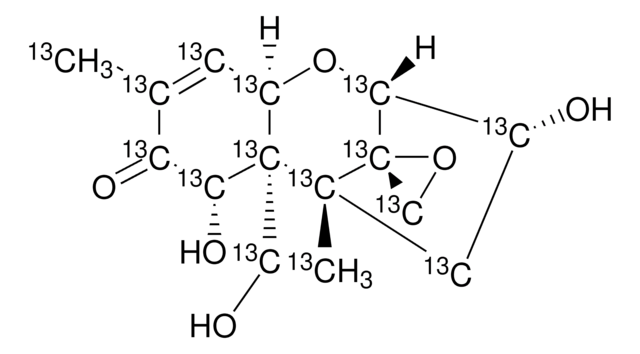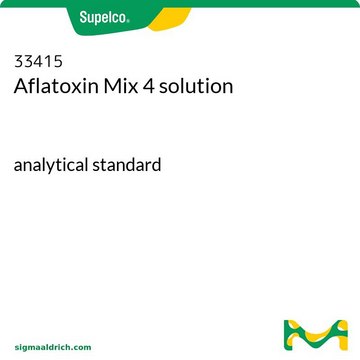IRMM315
4-Deoxynivalenol in acetonitrile
IRMM®, certified reference material
Synonyme(s) :
Deoxynivalenol solution
About This Item
Produits recommandés
Qualité
certified reference material
Agence
IRMM®
Fabricant/nom de marque
JRC
Application(s)
general analytical
Format
matrix material
Température de stockage
2-8°C
Chaîne SMILES
CC1=C[C@H]2O[C@@H]3[C@H](O)C[C@@](C)([C@]34CO4)[C@@]2(CO)[C@H](O)C1=O
InChI
1S/C15H20O6/c1-7-3-9-14(5-16,11(19)10(7)18)13(2)4-8(17)12(21-9)15(13)6-20-15/h3,8-9,11-12,16-17,19H,4-6H2,1-2H3/t8-,9-,11-,12-,13-,14-,15+/m1/s1
Clé InChI
LINOMUASTDIRTM-QGRHZQQGSA-N
Vous recherchez des produits similaires ? Visite Guide de comparaison des produits
Description générale
Remarque sur l'analyse
IRMM315
Informations légales
Mention d'avertissement
Danger
Mentions de danger
Classification des risques
Acute Tox. 4 Dermal - Acute Tox. 4 Inhalation - Acute Tox. 4 Oral - Eye Irrit. 2 - Flam. Liq. 2
Code de la classe de stockage
3 - Flammable liquids
Classe de danger pour l'eau (WGK)
WGK 2
Point d'éclair (°F)
35.6 °F - closed cup
Point d'éclair (°C)
2.0 °C - closed cup
Choose from one of the most recent versions:
Certificats d'analyse (COA)
Sorry, we don't have COAs for this product available online at this time.
If you need assistance, please contact Service Clients
Déjà en possession de ce produit ?
Retrouvez la documentation relative aux produits que vous avez récemment achetés dans la Bibliothèque de documents.
Notre équipe de scientifiques dispose d'une expérience dans tous les secteurs de la recherche, notamment en sciences de la vie, science des matériaux, synthèse chimique, chromatographie, analyse et dans de nombreux autres domaines..
Contacter notre Service technique







